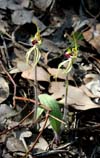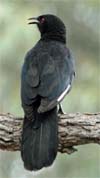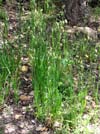Orchid Habitat Preservation
Arachnorchis (Caladenia) rosella habitat saved!Good news, the habitat of Arachnorchis (Caladenia) rosella in Australia that Dr Randall Robinson wrote about has been purchased. A philanthropist that read the article on the Orchid Conservation Coalition website donated the additional funds needed to purchase the habitat. The purchase of the land happened on May 23, 2009 by a coalition of the Trust For Nature, Dunmoochin Foundation, the local people and the very generous philanthropist. After the successful auction bid there is enough money left over for management of the habitat.
Dr Robinson says, “We went through too many bottles of champagne after the auction! Needless to say we are all just over the moon. Thank you so much for your input. The monies we gained through the philanthropist that found us through your website tipped us over the edge and allowed us to have a wonderful outcome.”
Everyone should be proud of the successful preservation of the habitat of Arachnorchis (Caladenia) rosella. There are only about 140 known plants in the wild. So this purchase is very important. It is a good example of how networking and getting information out about orchid conservation can make a positive impact. Thanks to all the people, orchid societies, businesses, and conservation organizations involved in the Orchid Conservation Coalition may we continue to have successes.
Mark Sullivan

Arachnorchis (Caladenia) rosella insitu photo by Dr. Randall W. Robinson
Arachnorchis (Caladenia) rosella text by Dr. Randall W. Robinson
Your help is needed to help save one of the last habitats of the endangered Rosella Spider Orchid. Local residents, the Dunmoochin Foundation and the Trust for Nature have expressed interest in purchasing the land. Subsequently, there is a proposal to form a consortium of people and groups to purchase the land. Even with all the pooled resources, there is not enough money to make the purchase and mange the plants. We are dedicated to save this special wild orchid species, but we need financial help. Both the Trust for Nature https://www.trustfornature.org.au/ and the Dunmoochin Foundation https://www.dunmoochin.org/ are charitable trusts. You can contact either one.
The following is information from Dr. Randall Robinson on the Rosella Spider Orchid and its current habitat preservation status.
In 1981 I went to visit my friend,
Geoff Carr in
Geoff,
Unfortunately, in the time between my visit and Geoff describing the
species,
its numbers in the wild have dwindled. The site has become invaded by
the
introduced grass Briza maxima
(Quaking Grass) which
competes for the meager
nutrients and available water at the site. Another threat is the
locally common
bird species the White-winged Chough. A bird that looks superficially
like a
crow or raven with bright red eyes. These larrikin, slightly maniacal
birds
live in colonies and behave much like chickens, picking and scratching
through
the leaf litter eating just about anything including orchid tubers.
Housing development which brings an increasing number of people with
their fireplaces and wood burning stoves into the area is a greater
threat.
Cam Beardsell is a very strong advocate for this beautiful
species. Before I met Cam, he was recording every detail
about
each plant in the remaining colonies. Over the past 25 years, Cam has
been the lone caretaker of this precious orchid. He has
protected
most of the plants from the Cloughs' and rabbits' diets. The
weeds that appear near the plants have been meticulously removed by
hand. Even the small wattles that
the
pollinators rely on for food have been replanted. The solitary female
pollinator bees collect the wattle pollen and store it as
small
balls in their nests in the ground. They lay their eggs on
the
pollen balls and the larvae use them as food.
Others have helped to sustain this
orchid in situ. The
Australian Native Orchid Society in cooperation with the Royal
Botanic
Gardens Melbourne has carried out in vitro propagation to reintroduce
the orchid into a suitable wild habitat. The Trust for Nature in
Despite all these efforts, these orchids continue to decline in
number. This was mainly attributed to the drought that we
have
had for the past decade. Caladenia
rosella is now listed as Endangered
under the Federal Environment Protection and Biodiversity Conservation
Act and
the State of
Recently, a block of land was purchased to build a house. Needless to say, the local council and the local residents did everything in their power to stop this development. The Caladenia rosella grows on this block of land. Clearing the land for development with attendant gardens, sheds and water tanks would have destroyed not only the plants, but also the possibility for future growth. There are only about 140 known plants in the wild.
The developer, unhappy with a rejection of development from the local council, took his case to the Victoria Civil and Administrative Tribunal (VCAT). Several in the local community argued the case against development, but our efforts failed. Even invoking the state and federal legislation did not sway the decision of VCAT. A slight ray of hope appeared at the end of the hearing. The developer agreed to a list of conditions to be met before any building was done. There was a stipulation by the federal government in cooperation with the state government to halt any development until it could be established exactly where the plants occurred on the block of land. This spring, the orchid recovery team of the Department of Sustainability and Environment with members of the Dunmoochin Landcare Group located a thriving colony of the Rosella Spider Orchid growing in the exact same place as in the past. Other plants in the area are Arachnorchis parva (Small Green-comb Spider Orchid) and the small shrub, Leucopogon parviflorus (Common Beard Heath).
The conditions on the developer have proved too great for him to meet and he is in the process of selling the block of land.
Dr.
Randall W. Robinson
School of Biomedical & Health Sciences
Victoria University
A shorter article with picture for orchid society newsletters: A shorter article with picture for orchid society newsletters: https://www.orchidconservationcoalition.org/pdf/articles/arosellaconservation.pdf






